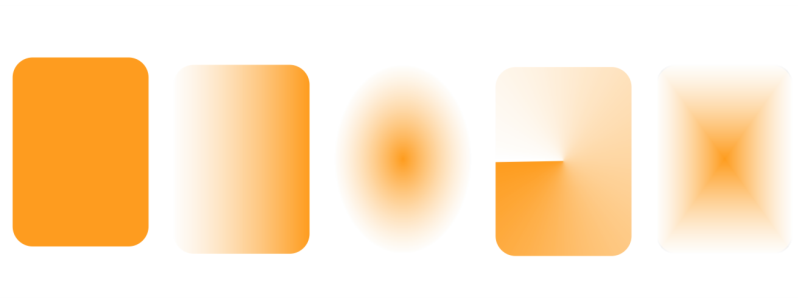Quick links to procedures on this page:
Fountain transparency makes the object fade from one transparency value to another. The fountain transparency can be linear, elliptical, conical, or rectangular.
From left to right: Original object with a linear, elliptical, conical, and rectangular transparency applied.
The application provides a collection of fountain transparencies that you can access. You can browse the available transparencies, search by keyword, mark transparencies as favorites, and sort them. You can also download additional fill packs, which can be used as transparencies. For more information, see Finding and viewing fills and transparencies.
You can create a fountain transparency by adding and removing nodes, and specifying a transparency value for each node. You can also reverse, mirror, resize, or skew a fountain transparency, or apply other transformations.
After you create a fountain transparency, you can save it for future use or share. For more information, see Saving fills and transparencies.
| 2 . |
Click Object  Object properties. Object properties. |
| 3 . |
In the Transparency area of the Object properties docker, click the Fountain transparency button  to display fountain transparency options. to display fountain transparency options. |
| 4 . |
Open the Transparency picker, and double-click a thumbnail. |
|
|
|
|
|
Click the Fill button  or the Outline button  in the Transparency area of the Object properties docker.
|
|
|
Click the Edit transparency button  in the Object properties docker, and specify the settings you want.
|

You can also click the Transparency tool  in the toolbox, and use the controls on the property bar to apply a fountain transparency.
in the toolbox, and use the controls on the property bar to apply a fountain transparency.
For information about how to find transparencies in the Transparency picker, see To find, filter, and sort fills and transparencies.
| 2 . |
Click Object  Object properties. Object properties. |
| 3 . |
In the Transparency area of the Object properties docker, click the Fountain transparency button  to display fountain transparency options. to display fountain transparency options. |
|
|
|
|
|
|
|
|
|
|
|
|
|
|
|
|
|
Click the Free scale and skew button  .
|
|
|
Click the Edit transparency button  , and click one of the following buttons:
|
|
|
Click the Edit transparency button, and click the Set to default button  to unlock the fountain steps, and type a value in the Fountain steps box.
|
|
|
Click the Edit transparency button, and move the Acceleration slider.
|
|
|
Click the Edit transparency button, and click the Smooth button  .
|
|
|
Click the Edit transparency button, and type values in the Transparency width and Transparency height boxes.
|
|
|
Click the Edit transparency button, and type values in the X and Y boxes.
|
|
|
Click the Edit transparency button, and type a value in the Skew box.
|
|
|
Click the Edit transparency button, and type a value in the Rotate box.
|

To apply the transparency only to the fill or the outline of the object, click the Fill button  or the Outline button
or the Outline button  .
.
You can also click the Transparency tool  in the toolbox. To adjust the transparency, use the controls on the property bar or the interactive vector handles that appear on the object.
in the toolbox. To adjust the transparency, use the controls on the property bar or the interactive vector handles that appear on the object.
You can also drag colors, which are converted to grayscale, from the color palette onto the transparency nodes. Alternatively, if the Transparency tool is selected, you can drag the colors onto the object’s interactive vector handles  .
.

Not all suite components documented in this Help are available in our Trial, Academic, and OEM versions. Unavailable components may include Corel applications, product features, third-party utilities, and extra content files.
Copyright 2018 Corel Corporation. All rights reserved.

in the toolbox, and use the controls on the property bar to apply a fountain transparency.
or the Outline button
.
in the toolbox. To adjust the transparency, use the controls on the property bar or the interactive vector handles that appear on the object.
 .
.![]()